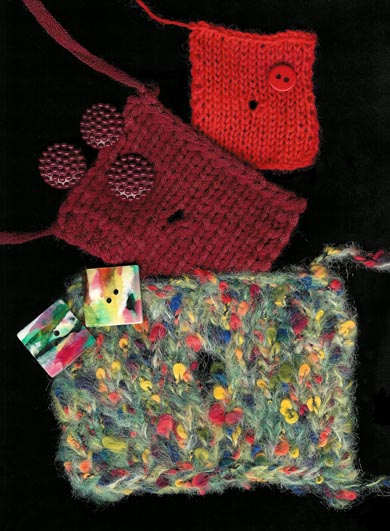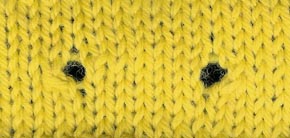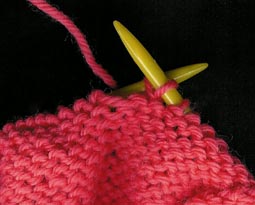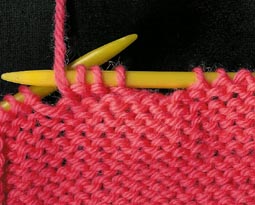| 26:
Buttonholes
Knitted buttonholes need to be a size
that will fit a button that is in a reasonable proportion to the
thickness of the yarn used to make the garment. Huge buttons on a
fine yarn will pull the fabric, and little buttons on thick knitting
will not hold the garment together without slipping out of the
buttonholes.
Hand-knitted buttonholes have a tendency to stretch with wear, so
make the smallest possible buttonhole that will fit over the button
that you have decided to use.
The easiest buttonhole to make almost works like magic. The hole is
usually the perfect size for a button that suits the yarn used for
the garment [pic 1].

1: The magic buttonhole. Easy to work and always seems
to be just the right size for a button that suits the particular
yarn used.
---
On either knit or a purl row, work to the
appropriate buttonhole position, knit two stitches together, then
take the yarn over the needle to compensate for the lost stitch and
to make the hole. Continue knitting to the next buttonhole. Or, take
the yarn over the needle and then knit the next two stitches
together. On the next row, knit the yarn-over as an ordinary stitch.
Either way, the result is the same sized buttonhole and it doesnít
matter which way it is worked [pic 2].

2: Buttonholes worked in two different ways look
alike.
---
Occasionally, if you have a large decorative
button, you may need to make a long, horizontal buttonhole. Itís
difficult to form a long buttonhole without distorting some
stitches, and knitters try so many different ways to navigate around
this problem, but I find the following method is the easiest to work
and gives a good result, especially when worked on the purl side of
the knitting.
At the appropriate place in a purl row, cast off the required number
of stitches knitwise, then purl to the next buttonhole and repeat,
or finish the row if you are only working one buttonhole [pic 3,4].


3: (left) Purl row start casting off stitches
knitwise.
4: (right) Four stitches have been cast off.
NEXT PAGE >>
chapter page: 1 | 2 |
3 | 4
|